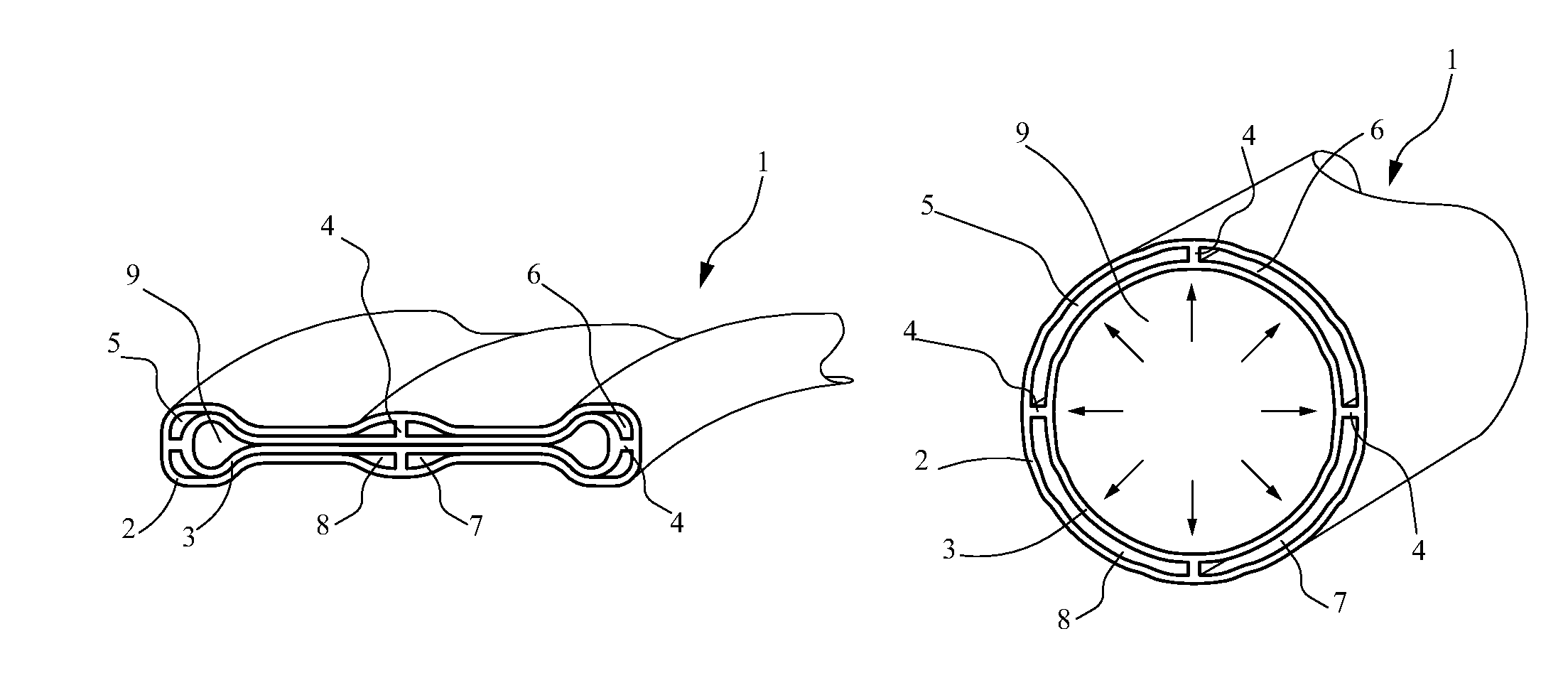Composite tubular structure
a tubular structure and composite technology, applied in the field of tubular structures, can solve the problems of reduced mechanical performance, inconvenient use, and inconvenient use, and achieve the effects of reasonable strain, convenient plastic folding, and convenient us
- Summary
- Abstract
- Description
- Claims
- Application Information
AI Technical Summary
Benefits of technology
Problems solved by technology
Method used
Image
Examples
first embodiment
[0044]A first embodiment is represented in reference to FIGS. 1A, 1B and 1C. The installation of a structure, which could either be a pipeline / flowline or a downhole casing as in the present description, starts from a multi-layered structure 1 in a longitudinally flattened shape (FIG. 1A). The multi-layered structure 1 which will most often be metallic includes a wall composed of a internal layer 3 and a external layer 2 of identical thickness, each pressed against one another and linked up by four bulkheads 4. Under a longitudinal flattened shape, the section of the structure is optimized to minimize its folding inertia on one radial axis to be easily wound on a spool of small diameter.
[0045]The internal layer 2 isolates an internal volume 9 and along with the external layer 3 and the four bulkheads 4, isolate four intermediate cavities 5, 6, 7 and 8.
[0046]The volume 9 corresponds to the internal volume of the tubular structure while the intermediate cavities 5, 6, 7, 8 allow the c...
second embodiment
[0049]A second embodiment is represented referring to FIGS. 2A, 2B and 2C and illustrate the use of the principle of the invention as wellbore casing and particularly for mono-diameter casing. As before (FIG. 1A), the deployment of this tubular structure starts from a multi-layered metallic structure 20 in a somewhat longitudinally folded shape. The multi-layered metallic structure 20 includes a wall composed of an internal layer 3 and an outside layer 2 of identical thicknesses, each pressed against itself and linked up by four bulkheads 4.
[0050]Under its longitudinally crushed shape, the structure folding is optimized at the same time to minimize its bending inertia in one first axis to facilitate winding on spool of small dimension but also in order that the radial dimension perpendicular to the first axis is less than the diameter of a drift circle 25 in order to be able to lower it directly into a well having a passage with a drift circle 25. The volume 9 corresponds to the int...
third embodiment
[0055]A third embodiment is represented referring to FIGS. 5, 5A, 5B, 5C and 5D. The deployment starts from multi-layered metallic casing structure 30 in a longitudinally flattened shape. The multi-layered metallic structure 30 includes a wall composed of an internal layer 3 and an outside layer 2 of identical thicknesses, each pressed against itself and linked up by four bulkheads 4. Under a longitudinal flattened shape (FIG. 5A), the section of the structure is optimized to minimize its folding inertia to be easily wound on a spool of small diameter. It features a radial dimensions larger than the diameter of the drift circle 25.
[0056]After unwinding and straightened by rollers 19 and before being lowered into the well, the metallic structure 30 is deformed in the plastic range of the metal by mechanical action of rollers 16 and pebbles 17 which apply a lateral pressure directly over the structural layer 2 and indirectly over the structural layer 3 so that its radial dimensions is...
PUM
 Login to View More
Login to View More Abstract
Description
Claims
Application Information
 Login to View More
Login to View More - R&D
- Intellectual Property
- Life Sciences
- Materials
- Tech Scout
- Unparalleled Data Quality
- Higher Quality Content
- 60% Fewer Hallucinations
Browse by: Latest US Patents, China's latest patents, Technical Efficacy Thesaurus, Application Domain, Technology Topic, Popular Technical Reports.
© 2025 PatSnap. All rights reserved.Legal|Privacy policy|Modern Slavery Act Transparency Statement|Sitemap|About US| Contact US: help@patsnap.com



